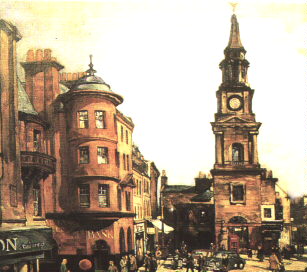FALKIRK STEEPLE
From a painting by William Aitken, D.A of Falkirk High Street in 1957.
This new town steeple was erected in 1814. Falkirk had, from the 16th century at least ,
been a town with a tolbooth steeple. The first was replaced in 1697 by a building which
adjoined the court and prison close to the present site in the High Street. In 1776 a
clock was installed.In 1801 the steeple was cast to the ground when it was found to be
listing dangerously by some 15". The present steeple was designed by David Hamilton,
later designer of Larbert Parish Church.
For more historical information on Falkirk read the 1841 New Statistical Account

The JOHN STEWART gravestone
The first battle of Falkirk in 1298 saw the death of many of the great and powerful of the Scottish nobles and chieftains. Many of the fallen were carried to the kirkyard of Falkirk, and there they remain, their graves marked by fine memorials. A flat stone in the kirkyard marks the grave of Sir John Stewart, whose gallant men of Bute fell to a man in a vain attempt to save their chief.

ROMAN BUILDINGS
A building known as Arthur's Oven ( locally known as Arthurs O'on) stood near the Stenhouse mansion of Sir Michael Bruce. He demolished it in 1743 to provide a cheap supply of dressed stones for a new weir on the River Carron. When the scholars of the day discovered this act of vandalism they did not spare Sir Michael but prayed that " if there is a pit deeper than the ordinary destined for the reception of such villains and rascals, condem him to the bottom of it "
